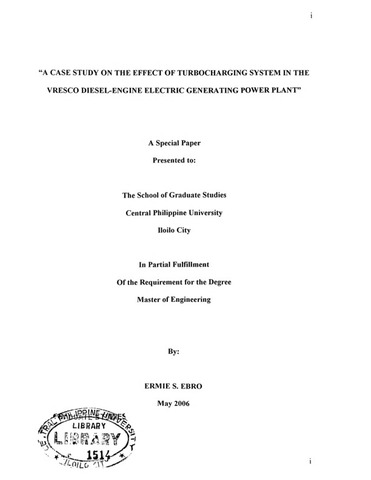A case study on the effect of turbocharging system in the VRESCO diesel-engine electric generating power plant
| dc.contributor.adviser | Hechanova, John Dandee D. | |
| dc.contributor.author | Ebro, Ermie S. | |
| dc.date.accessioned | 2021-06-02T06:40:44Z | |
| dc.date.available | 2021-06-02T06:40:44Z | |
| dc.date.issued | 2006 | |
| dc.identifier.citation | Ebro, E. S. (2006). A case study on the effect of turbocharging system in the VRESCO diesel-engine electric generating power plant (Unpublished Master's special paper). Central Philippine University, Jaro, Iloilo City. | en_US |
| dc.identifier.uri | https://hdl.handle.net/20.500.12852/966 | |
| dc.description | Abstract only | en_US |
| dc.description.abstract | Man has an inquisitive mind. He learned something differently out of curiosity in order to harness the power of nature. According to Daniel J. Boorstin, “We live and learn- which means we constantly discover. But inventions have been rare and far between.” This age-long struggle it seems never ending as men became numerous and their lives more complex. Power was first derived from the ox trudging his circle, and man treading his wheel from primitive capstan and rope pulley block, then from the windmill, and finally from today’s water turbine. The most recent source of power is the nuclear reactor, and much remains to be done in the great underdeveloped areas of the earth. Today, we understand the engineering problem facing us, and we are finding ways and means, more refined and productive solution of meeting new challenges in the future. The increasing demands for maximum power output of an engine since its discovery yield stressful human activity and create more pressures and thermal loads to a supercharged engine either of marine or stationary type, carried out by exhaust-driven turbocharger. This free-running unit called turbochargers is a self-contained unit made up of a low pressure centrifugal blower, both on a common shaft which mechanically independent of the engine in providing a greater mass of air in the cylinder in which larger amount of fuel can be burned. This innovation is not simply adding equipment to non-supercharged engines but rather to improve conversion of heat energy into mechanical work during the expansion stroke, as Dr. Rudolf Diesel emphasizes in his patent of 1892, describing diesel engines as distinguished from other internal combustion power sources primarily by the low volatility of the fuel they used, and by the means they employ for the ignition of that fuel. Consequently, combustion takes place, as soon as required ignition temperature is reached. Expansion of the combustion gases drives the piston downward. Towards the bottom dead center and exhaust gases begin to leave the cylinder through upward stroke until top dead center which in turbocharged engines, both valves remain open momentarily to provide more effective scavenging of exhaust gases by the greater intake air pressure. These exhaust gases provide considerable amount of energy in driving a turbine wheel which in turn drives a blower impeller to provide air at increased pressure for the cylinder. The observation of some sensible energy in the exhaust gases have been tried in merchant vessels by providing waste-heat boilers which utilize the engine exhaust to provide steam for many uses of the ship. Two common applications of exhaust heat recovery in electric generating plants are to provide warm water for various purposes within the plant and to heat ventilating air for the plant Historically, the progress of mankind in the production and application of power using his God-given scientific talents began to discover and to interpret certain of the*1 laws of nature in acquiring mastery over the forces of nature and an ability to create mechanical slave in the form of electrical or mechanical power-producing units | en_US |
| dc.format.extent | i, 69 leaves | en_US |
| dc.language.iso | en | en_US |
| dc.subject.ddc | GSL Theses 620.0072 Eb78 | en_US |
| dc.subject.lcsh | Turbochargers | en_US |
| dc.subject.lcsh | Power-plants | en_US |
| dc.subject.lcsh | Diesel motor | en_US |
| dc.subject.lcsh | V-M-C Rural Electric Service Cooperative, Inc. | en_US |
| dc.title | A case study on the effect of turbocharging system in the VRESCO diesel-engine electric generating power plant | en_US |
| dc.type | Special paper | en_US |
| dc.description.bibliographicalreferences | Includes bibliographical references | en_US |
| dc.contributor.chair | David, Fely P. | |
| dc.contributor.department | College of Engineering | en_US |
| dc.description.degree | Master of Engineering | en_US |


